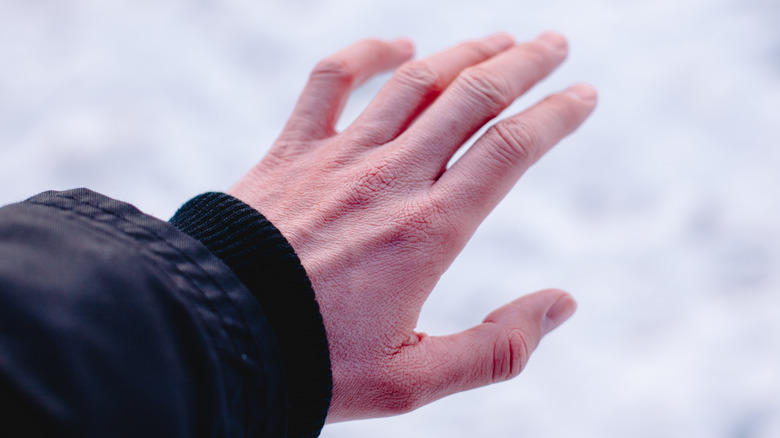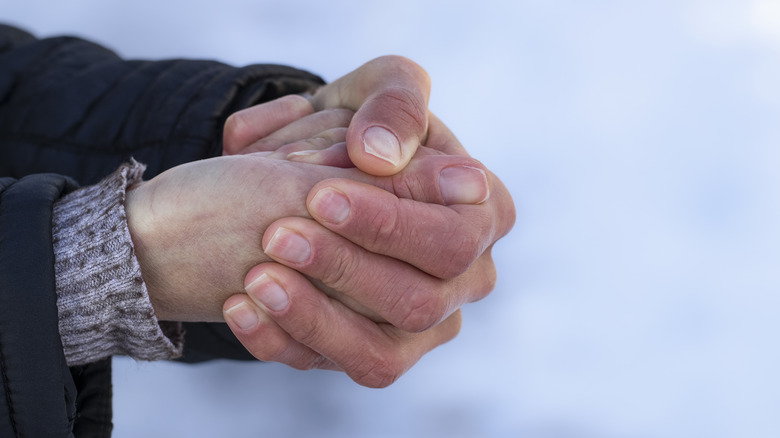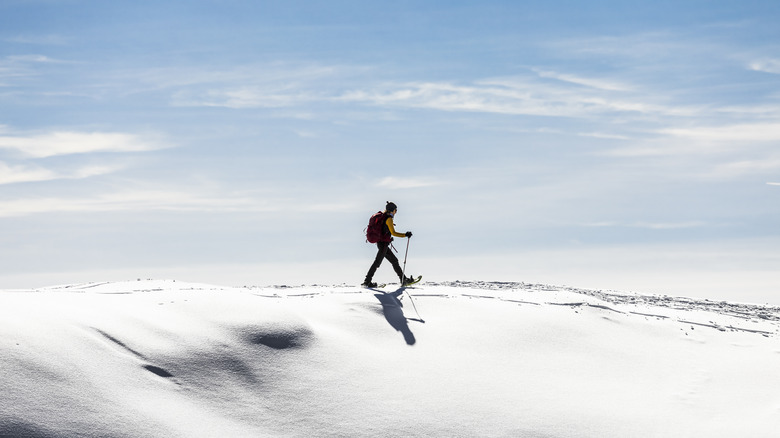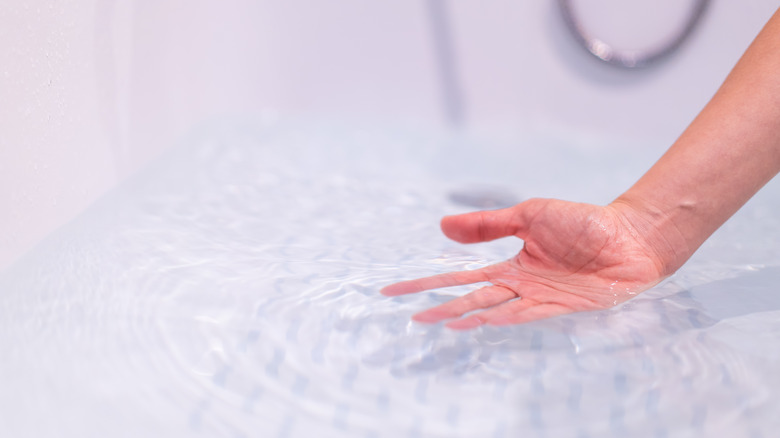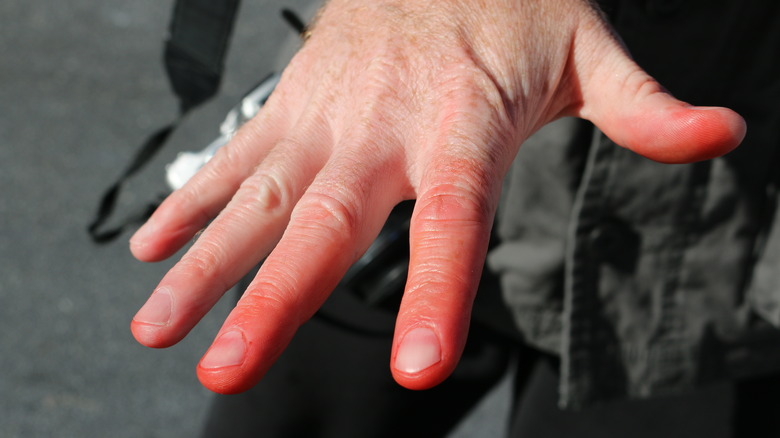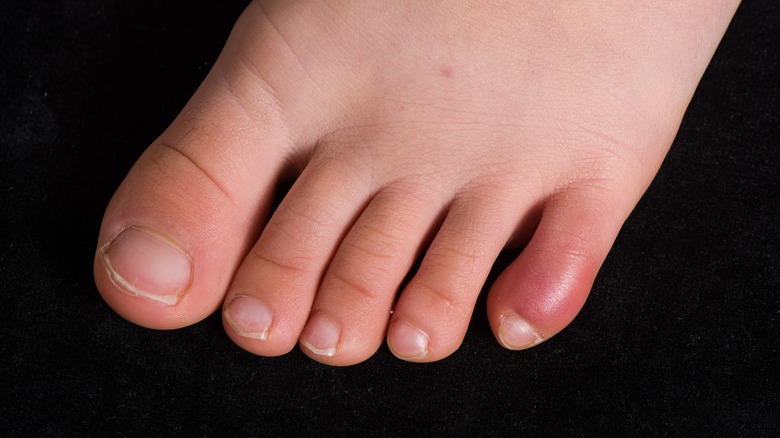Signs Of Frostbite You Shouldn't Ignore
Even if you aren't planning a trip to the Arctic any time soon, it's important to keep an eye out for early signs of frostbite when spending time outdoors whenever the temperature drops below freezing. Frostbite, or damage to skin and tissue from exposure to freezing temperatures, can set in quickly. It can also numb your skin so you don't feel its effects until it's too late. If you're wearing wet clothes or are out in the wind, it can happen at even warmer temperatures.
Though it can happen to anyone who experiences prolonged cold exposure, in particular people without adequate housing or with an underlying medical condition that makes them more sensitive to cold, mountaineers are one of the groups most likely to experience frostbite. As noted in a 2005 article in the British Journal of Sports Medicine, in a study of more than 600 mountaineers, more than 70% had experienced some degree of frostbite.
While early frostbite symptoms can be mild, it's important to watch for them because more severe damage is irreversible.
Pins and needles
Even if you don't feel too cold, it's vital that you never ignore a prickling, stinging, or itching sensation while out in the cold. This feeling, often called "pins and needles," would likely begin in your fingertips, toes, nose, or other extremities that are exposed to the cold. While it may not seem particularly severe, it is a sign that your body is too cold.
Human skin is more than 60% water, and unfortunately, that means it's possible for skin to literally freeze in the cold. As ice crystals form, you feel the unpleasant prickling sensation like you're being poked with something sharp. To prevent serious damage to the skin and underlying tissue, it's vital that you get out of the cold, change out of any wet clothes, and slowly rewarm the affected areas. At this stage of frostbite, it's likely that you can prevent any serious damage by returning to a warm, dry place that's protected from the wind, changing out of wet clothes, and rewarming the area where you felt the prickling sensations — but if it's possible to check in with a doctor, it would be a good idea.
Lack of sensation
Sometimes, the feeling of pins and needles in your feet or fingers might seem to go away on its own without you having to warm it up at all – but that isn't always a good sign, and definitely doesn't mean that it's safe for you to continue being outside in the cold. As your body freezes, the area often goes numb. Although it's less painful than feeling like you're being poked with needles, it is a sign that the frostbite is getting worse, not better. Like with all early signs of frostbite, it's important to get out of the cold immediately if you notice that you're losing feeling in your fingers and toes.
Numbness can also occur at the most serious levels of frostbite when the tissue has been irreversibly damaged. At that stage, you would also be experiencing more obvious symptoms, like blackening and hardening of the tissue and issues with joints and muscles. If you believe you may have severe frostbite, this is a medical emergency and requires immediate attention.
Pain warming up
If you think you might be experiencing symptoms of frostbite, one of the first things you should do after getting indoors and changing out of any wet clothes is slowly rewarming the affected areas in warm water. If you have frostbite, your skin getting warm again, either because you're intentionally rewarming it or because you came inside from the cold, can be very painful.
The severe pain as blood begins to flow back into frostbitten areas will lessen with time, but an unpleasant throbbing may last for weeks. In cases where "frostnip" has already progressed to frostbite, it's best for rewarming to be done by a medical professional, who can keep the water right around 38°C or 100°F, prevent infection, and provide painkillers to get through this process. If a person is in the wilderness and can't get to a doctor, they might actually be better off waiting until they reach civilization to try to rewarm their frostbitten extremities. While leaving a frostbitten area cold is dangerous, painfully warming it up only to have it refreeze later can be even more dangerous.
Red fingertips
One of the first things to look out for if you're out in the cold is if your skin is changing color. While many people with pale skin tones may regularly have slightly rosy cheeks or a pink nose in the cold, fingertips, noses, ears, and toes turning red is a telltale sign that a person is being affected by the cold, as is skin that seems unusually pale, yellow, purple, or gray.
If you have a dark skin tone, it may be trickier to spot these subtle color changes, but you should still be vigilant. In fact, as noted by a 2014 article in the European Journal of Applied Physiology, people who are of African descent, regardless of where they currently live, are more likely to experience injuries from the cold like frostbite, so it's important to be extra aware of any changes.
If your skin looks like it has changed color in an unusual way, you should quickly return to a warm place and change into dry clothes, even if your extremities don't feel too cold and tingly yet.
Warm skin
It's counterintuitive, but just because your skin feels warm doesn't mean you aren't experiencing frostbite. In fact, it can actually be a sign that the damage is getting worse. When frostnip progresses to frostbite, it may actually cause the skin to feel warm.
Sometimes, at an intermediate stage of frostbite, your skin may feel hard and cold as ice crystals form in the skin – but if the damage is progressing to the top layers of tissue, it may actually feel warm instead. You will likely also notice some swelling and redness in the affected area.
This is a highly dangerous symptom of frostbite to ignore. At this stage, it is wise to consult a doctor for help rewarm the area and monitor any blistering you may experience in the following days. Even though these symptoms are disturbing and painful, with proper care even frostbite damage that has progressed to this stage is fully reversible.
Blisters
While the initial damage from being out in the cold can be averted by rewarming the area, sometimes blisters will come out later. If you're seeing hard bumps, swollen areas, or blisters on your hands and feet several hours or even several days after being out in the cold, it's likely that you have had frostbite or similar cold damage.
With frostbite that has impacted your skin you might find your skin blistering painfully 12-36 hours later. If the frostbite was more severe and permanently damaged the tissue, major blistering can happen up to 2 days later. In both of these cases, it's vital that you receive ongoing medical care to prevent infections and worsening damage.
If you are experiencing hard, uncomfortable swollen bumps on the hands and feet that last for weeks at a time, you may actually be experiencing chilblains or perniosis. These can also blister, if the damage is severe enough. In general, you can prevent these by staying warm and dry, but if you experience particularly severe or frequent chilblains, it's a good idea to check in with a doctor.
